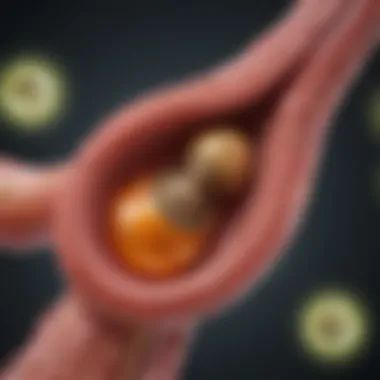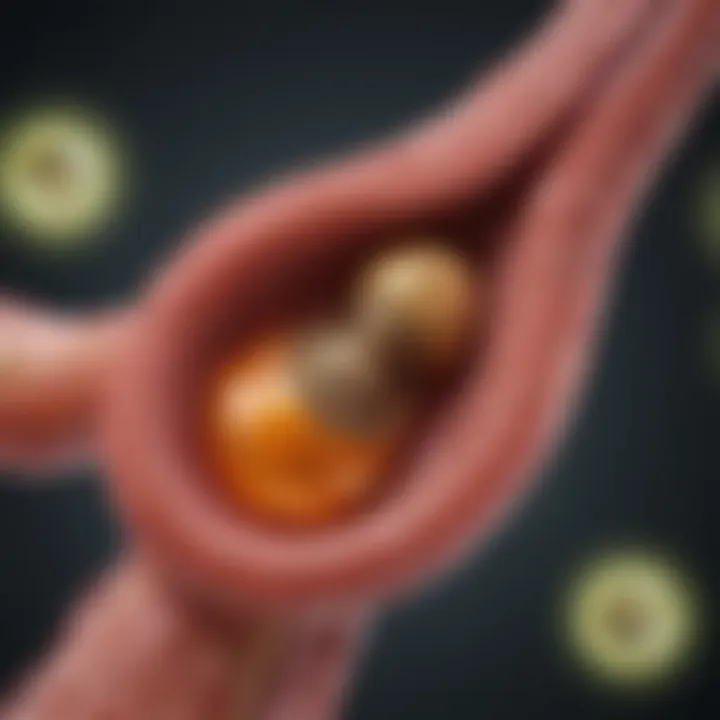Understanding Gallstones in the Bile Duct


Intro
Gallstones are a common yet intricate issue that affects many individuals worldwide. Among the various types of gallstones, those that lodge within the bile duct present unique challenges both for patients and healthcare providers. As the bile duct plays a crucial role in the digestion process, understanding the implications of gallstones in this area can enhance our awareness and management of this condition. This article aims to break down the complexities surrounding bile duct gallstones, including their formation, symptoms, complications, and treatment options.
Key Concepts and Terminology
Definition of Key Terms
Before delving into the details, it's essential to clarify some key terms:
- Gallstones: Solid particles that form in the gallbladder, which can vary in size and composition—most commonly cholesterol or bilirubin.
- Bile Duct: A tubular structure that carries bile from the liver and gallbladder to the small intestine.
- Cholecystitis: Inflammation of the gallbladder often caused by blocked bile ducts due to gallstones.
- Cholangitis: An infection of the bile duct that can occur when a stone obstructs the flow of bile.
Concepts Explored in the Article
In this article, several interconnected concepts will be considered:
- The physiological role of the bile duct in digestion and bile flow.
- The pathophysiology of gallstone formation, particularly in relation to the bile ducts.
- Symptoms associated with bile duct obstruction and complications that may arise from untreated gallstones.
- Current treatment options, from non-surgical approaches to surgical interventions.
Findings and Discussion
Main Findings
Understanding the relationship between gallstones and the bile duct has significant implications for management and treatment. Here are some main findings from recent studies:
- Incidence Rates: According to various studies, around 10% to 20% of gallstones become impacted in the bile duct.
- Symptomatology: Symptoms such as jaundice, pain in the right upper abdomen, and fever can indicate complications like cholangitis or pancreatitis that need urgent care.
- Treatment Modalities: Endoscopic retrograde cholangiopancreatography (ERCP) has emerged as a favored non-surgical option for removing stones from the bile duct.
"The interplay between bile duct mechanics and gallstone pathology is a focal point in devising effective treatment strategies."
Potential Areas for Future Research
Although significant progress has been made, there remains much to learn. Potential areas for future inquiry could include:
- The genetic factors influencing gallstone formation, assessing how family history may play a role.
- Longitudinal studies on the effects of diet and lifestyle on gallstone incidence and management.
- Enhanced imaging techniques that may lead to improved diagnosis and early intervention strategies.
In wrapping things up, understanding gallstones in the bile duct not only protects patient health but also raises awareness among clinicians and researchers about this prevalent condition. The dynamic nature of the bile duct and its propensity for obstruction underscores the necessity for ongoing study and innovation in treatment protocols.
Foreword to Gallstones
When we scan the landscape of digestive health, gallstones stand out as a significant concern. They aren't just a medical trivia; they can lead to a wide range of complications that require serious attention. Understanding these stones—whose formation, symptomatology, and possible treatments are often puzzling—becomes a vital pursuit. In this article, we aim to demystify gallstones, particularly those residing in the bile duct.
Understanding the definitions, types, and the underlying mechanisms of gallstones lays the foundation for exploring their impact on health. It is crucial for medical professionals, students, and anyone keen on health matters to recognize the complexities involved in its pathology. Knowing what gallstones are and how they conjure health challenges equips readers with the necessary knowledge to face or assist others in navigating this condition.
Considering the significance of education around this topic, we will define gallstones in detail and classify them into distinct categories, enabling a richer comprehension of their nature and implications.
Definition of Gallstones
Gallstones are solid particles that form in the gallbladder, a small organ beneath the liver, functioning mainly to store bile—a digestive fluid produced by the liver. The stones can range in size from a grain of sand to that of a golf ball. They stem from inefficiencies in the balance of substances that form bile, primarily cholesterol, bile salts, and bilirubin. When these substances are present in excess or out of balance, they can precipitate out of solution, forming stones.
Types of Gallstones
Gallstones are broadly classified into three main types:
- Cholesterol Gallstones
Cholesterol gallstones account for around 80% of gallstone cases. They largely consist of hardened cholesterol deposits, which result when there’s too much cholesterol in the bile or not enough bile salts to dissolve it. These stones can be yellowish-green due to the high cholesterol content. Their notable characteristic is that they are often asymptomatic; some individuals may carry them for years without ever realizing it. However, once they cause blockages in the bile duct, symptoms may suddenly arise. - Pigment Gallstones
Pigment gallstones are smaller and darker, primarily composed of bilirubin, a breakdown product of red blood cells. People with liver cirrhosis, biliary tract infections, or specific blood disorders are more likely to suffer from these types. Due to their higher association with complications like obstructive jaundice, they warrant careful monitoring. Their unique feature is that they often indicate a more systemic health issue, prompting a more profound investigation beyond mere stone management. - Mixed Gallstones
As the name suggests, mixed gallstones contain both cholesterol and bilirubin. They often exhibit varying sizes and shapes, making them particularly troublesome as they may encompass characteristics from both cholesterol and pigment stones. Their development typically results from a combination of the conditions that lead to the other types, thus indicating varying risk factors. These stones can be tricky because they may not only block bile flow but can also exacerbate the existing conditions of those who harbor them.
In essence, understanding these specific types provides clarity in addressing gallstone-related health issues. By recognizing their defining characteristics, we can pave the way for better management and treatment approaches, ultimately benefiting patient outcomes.
The Anatomy of the Bile Duct
Understanding the anatomy of the bile duct is critical for both diagnosing and managing gallstones that may occur within this system. The bile duct plays a vital role in the digestion process by transporting bile from the liver and gallbladder to the small intestine. When gallstones get stuck in this duct, they can cause a series of complications that might significantly affect the patient's health and wellbeing. Therefore, a comprehensive grasp of its structure and function is essential.
Structure of the Bile Duct System
The bile duct system is not just a simple tube but rather a network of channels that includes the hepatic ducts, the cystic duct, and the common bile duct. Each component has specific characteristics that contribute to the overall functionality of the digestive system. Here’s a straightforward breakdown of the key elements that form the bile duct system:
- Hepatic Ducts: These ducts emerge from the liver, responsible for carrying bile that the liver produces. They split into right and left hepatic ducts, which drain corresponding lobes of the liver.
- Cystic Duct: This duct connects the gallbladder to the common bile duct. It stores bile and allows for its release when needed, especially after eating fatty foods.
- Common Bile Duct: This is the main duct that channels bile from both the hepatic ducts and the cystic duct into the duodenum, the first part of the small intestine.
The structure is both intricate and efficient, with the overall length of the bile duct system measuring around 7 to 8 centimeters in adults. The diameter varies, but it's typically about 0.5 centimeters. The anatomy of the bile duct can be influenced by various conditions, which can lead to dilatation or obstruction, thus complicating the passage of bile and exacerbating gallstone-related issues.
Function of the Bile Duct
The primary function of the bile duct system is to facilitate the flow of bile, which is crucial for digestion, especially the emulsification of fats. Without an efficient bile duct system, the body struggles to digest and absorb fats properly, leading to digestive problems. Here are some specific functions:
- Bile Transport: The duct system serves as a conduit for carrying bile. This transport is essential because it helps neutralize stomach acid and provide necessary enzymes for fat digestion in the small intestine.
- Regulation of Bile Release: The sphincters at the entrance of the bile duct play a crucial role in controlling the release of bile, only allowing it to flow into the intestine as required. The sphincter of Oddi is one of the major muscle valves in the bile duct system, regulating bile discharge.
- Clearance of Waste: By facilitating the flow of bile, the bile duct system aids in the removal of waste products, including bilirubin, cholesterol, and toxins. This detoxification is vital for maintaining overall health.
Understanding these functions can help in grasping the significance of gallstones within this anatomy. When gallstones obstruct the bile duct, they can cause conditions like cholangitis or pancreatitis, which can lead to severe complications.
"The anatomy and functionality of the bile ducts are fundamental in understanding how gallstones can affect the body and lead to serious health issues. Knowing the structure and function lays the groundwork for effective diagnosis and treatment choices."
By studying these structural and functional nuances, healthcare professionals can better assess the implications of gallstones and make informed decisions in management and treatment.
Formation of Gallstones in the Bile Duct
The formation of gallstones within the bile duct is a critical component of understanding this disorder. Grasping how these stones develop is essential for both patient management and preventative care. Analyzing this formation not only sheds light on the physiological environments conducive to gallstone creation but also helps health professionals strategize treatment options more effectively. Understanding the formation processes leads to better patient education, helping individuals make informed lifestyle choices that could potentially reduce the risk of new gallstones.
Physiological Factors
Several physiological factors play pivotal roles in the development of gallstones in the bile duct. The bile itself, made primarily of cholesterol, bile salts, and bilirubin, needs to reach a delicate balance for healthy bile duct function. When this balance is disrupted, gallstones can form. Factors affecting this equilibrium include:


- Bile Composition: When there are excessive cholesterol levels or insufficient bile salts, the bile can become supersaturated with cholesterol, which then crystallizes and forms stones.
- Bile Stasis: Conditions that lead to prolonged retention of bile can catalyze stone formation. For instance, if the ducts are obstructed, bile accumulates, and this stagnation allows stones to develop more readily.
- Increased Bilirubin: Certain hemolytic disorders can raise bilirubin levels, leading to the formation of pigment stones, particularly in individuals who might already have other risk factors for gallstone disease.
Consequently, maintaining optimal physiological conditions is vital for preventing gallstones. Being cognizant of one’s health status, such as liver function and metabolic health, can inform individuals on managing their risks more effectively.
Biochemical Processes
Exploring the biochemical processes underlying gallstone formation provides further insight into this medical condition. The biochemistry of the bile plays a central role in regulating gallstone formation, as illustrated through several mechanisms:
- Nucleation: This is the initial stage where bile components crystallize to form the nuclei of gallstones. Impairment from the normal bile salt effect can lead to excessive crystallization, particularly under the right conditions of bile composition.
- Growth: Once nucleated, these crystals can undergo growth by accumulating additional cholesterol and calcium salts. Factors that favor this growth include increased cholesterol concentration in the bile, which can be exacerbated by obesity and rapid weight loss.
- Aggregation: This involves the clumping of smaller crystals into larger stones. Factors influencing this step include the presence of specific proteins that promote crystal fusion.
"Understanding these biochemical processes is crucial for developing targeted therapies and interventions aimed at mitigating the risk of gallstone formation."
This intricate interplay of physiological and biochemical factors underlines the complexity of gallstone formation, emphasizing the need for comprehensive diagnostic approaches in identifying at-risk individuals. By connecting the dots between these factors, clinicians can better predict, diagnose, and manage gallstone-related complications.
Symptoms of Gallstones in the Bile Duct
Understanding the symptoms of gallstones in the bile duct is crucial for timely diagnosis and treatment. These symptoms not only indicate the presence of gallstones but also surpass a mere workspace for discomfort, encompassing broader implications for health. Being aware of these signs can prompt individuals to seek medical attention swiftly, potentially averting serious complications. The significance of recognizing these symptoms lies in their role as a bridge to understanding one's health condition, eventually leading to appropriate management options.
Common Symptoms
When discussing gallstones in the bile duct, several common symptoms tend to surface, and recognizing them can make a world of difference. Here’s an overview of some key signs:
- Pain in the Upper Abdomen: Often described as intense or cramping, this pain may originate in the right side and radiate towards the back or shoulder blades. Many individuals report that this pain tends to coincide with meals, especially after consuming fatty foods, which are more difficult for the gallbladder to process.
- Nausea and Vomiting: These are not comfortable fellows at any time, but they can be particularly exacerbated by the presence of gallstones in the bile duct. Episodes of nausea can sometimes lead to vomiting, which may compound the sense of unease and discomfort.
- Jaundice: This manifests as a yellowing of the skin and eyes, due to a buildup of bilirubin. When a gallstone blocks the bile duct, it prevents bile from reaching the intestines, causing an accumulation of bilirubin in the bloodstream. Jaundice is not just a cosmetic issue; it indicates an underlying problem that requires immediate attention.
- Dark Urine and Light-Colored Stool: If your urine starts looking like strong tea, and your stool appears less vibrant than usual, it may be signaling an issue with bile flow. Dark urine can arise as the bilirubin levels rise, while pale stool is a result of bile not reaching the intestines as it normally would.
Recognizing these common symptoms can empower individuals to act proactively, and seek a healthcare provider for further evaluation. Ignoring these signs might lead to subsequent complications, steering one's health off-course.
Severe Symptoms and Complications
While common symptoms serve as initial warning signs, severe symptoms can indicate an urgent medical condition associated with bile duct gallstones. The following severe symptoms should never be taken lightly:
If you experience severe abdominal pain accompanied by fever chills, do not delay seeking medical assistance.
- Intense Abdominal Pain: Known as biliary colic, severe pain can occur suddenly and persist for lengthy periods. This may signal a more serious blockage due to gallstones lodging themselves within the duct.
- Fever and Chills: The presence of gallstones can lead to infections such as cholangitis. If accompanied by fever and chills, these symptoms often indicate a bacterial infection that may necessitate urgent care.
- Confusion or Altered Mental State: In severe cases where infection or inflammation progresses, an individual might exhibit confusion or disorientation. This could suggest a systemic response, pointing toward sepsis, which is a life-threatening condition.
- Pancreatitis: This condition arises when a gallstone obstructs the pancreatic duct. Symptoms include severe abdominal pain, nausea, vomiting, and fever. Pancreatitis can escalate quite quickly, making preventative measures all the more critical.
Understanding and identifying the severe symptoms associated with gallstones in the bile duct can guide individuals toward timely medical intervention. When symptoms escalate, staying alert could be the difference between a complication-free recovery and a more serious health event.
Complications Associated with Bile Duct Gallstones
Understanding the complications arising from gallstones in the bile duct is crucial for a comprehensive grasp of this medical condition. The presence of gallstones in the bile duct can lead to a range of serious health issues, underscoring the importance of timely diagnosis and intervention. Patients with bile duct gallstones may experience dire consequences if the stones are not promptly addressed. Hence, we need to explore the primary complications in detail.
Cholangitis
Cholangitis is a serious inflammation of the bile duct system, predominantly stemming from an obstruction caused by gallstones. The signs of cholangitis may include fever, jaundice, and abdominal pain, often collectively referred to as Charcot's triad. The cause? The blockage of the bile ducts leads to stagnant bile, promoting bacterial growth which can induce sepsis if not treated swiftly.
Here’s the crux:
- Involvement of the gallstones exacerbates the bile’s stagnation.
- Typical treatments vary from antibiotics to more invasive actions—like decompressing the bile duct.
The risks are daunting. A delayed response can not only extend recovery times but result in life-threatening conditions. Thus, understanding cholangitis emphasizes the critical nature of monitoring gallstone patients closely for any signs of obstruction or infection.
Pancreatitis
Another grievous complication linked with bile duct gallstones is pancreatitis. This is potent inflammation of the pancreas which occurs when ductal stones obstruct the pancreatits duct. The symptoms might include intense abdominal pain, nausea, and vomiting, making it a tumultuous experience for patients. The mechanism here is fairly straightforward: when a gallstone blocks the pancreatic duct, enzymes that are meant to digest food become trapped, leading to inflammation.
It’s essential to underscore:
- Acute pancreatitis can be a medical emergency.
- Often times it requires hospitalization, and in severe cases, it can result in chronic issues or even death.
The interplay between gallstones and pancreatitis illustrates the broader implications of duct obstruction. Being aware of these potential complications underlines the urgent need for proactive medical management in patients with gallstones.
Biliary Obstruction
Biliary obstruction occurs when gallstones block the flow of bile from the liver to the intestines. The results can be quite severe. Patients often experience abdominal distension, intense pain, and possibly even fever. This blockage can lead to serious complications like liver damage or jaundice, where the skin and eyes turn yellow due to excess bilirubin in the blood.
To further elaborate:
- Timely management is key; options include endoscopic interventions or surgical procedures to remove the stones.
- Unmanaged biliary obstruction can escalate to infections such as cholangitis or liver failure, a risk no one should take lightly.
In summary, the ramifications of complications stemming from bile duct gallstones are extensive and can profoundly impact patient outcomes. Recognizing these conditions highlights the necessity for continued research and improved diagnostic procedures, ultimately contributing to better patient care and treatment strategies.
Diagnosis of Gallstones in the Bile Duct
Diagnosing gallstones in the bile duct is a critical step in managing this condition effectively. The right diagnosis affects treatment decisions, which can alleviate symptoms and prevent complications. When gallstones form in the bile duct, they can lead to serious health issues, making accurate detection paramount.
Several methods are available to diagnose gallstones, each with its own pros and cons. Understanding these techniques is not just beneficial for healthcare providers but also illuminates the diagnostic journey for patients experiencing discomfort. This section elaborates on the imaging techniques and endoscopic procedures that aid in diagnosis, discussing their specific characteristics and value.
Imaging Techniques
Imaging techniques play an essential role in diagnosing bile duct gallstones. These non-invasive methods offer significant insights without the need for surgery. Here’s a closer look at three predominant imaging techniques:
Ultrasound
Ultrasound is often the first-line imaging technique for detecting gallstones. Its key characteristic is the use of sound waves to create images of organs and structures in the body. This method is particularly favored because it is non-invasive, does not involve radiation, and is relatively easy to interpret.
A unique feature of ultrasound is its capability to visualize gallstones in real-time. The technique allows for quick assessments, which is crucial, especially in emergency settings. Despite its advantages, there are limitations—ultrasound might miss smaller stones or those obscured by gas in the intestines.
Advantages of ultrasound include:
- Cost-effectiveness
- Portability and ease of use
- Wide availability in medical settings


But it has its drawbacks, such as potential inaccuracies in patients with obesity or excessive intestinal gas.
CT Scan
The CT scan stands out due to its ability to provide cross-sectional images of the body. This technique is beneficial in comprehensive assessments of gallstones and any associated complications. CT scans are particularly effective at identifying complications like pancreatitis, which may arise from obstructed bile ducts.
A notable characteristic of CT is its high resolution, capturing detailed internal structures. This makes it a popular choice, especially when ultrasound results are inconclusive. However, the downsides include exposure to radiation and higher costs compared to ultrasound.
"CT scans provide a detailed look at the bile duct system, but they come with their own risks, especially regarding radiation exposure."
Advantages of CT scans:
- High diagnostic accuracy
- Detailed imaging of adjacent organs and structures
Disadvantages include:
- Cost
- Radiation exposure
MRI
Magnetic Resonance Imaging (MRI) is another premier imaging technique that is particularly useful in demonstrating soft tissue contrast. One of the key strengths of MRI is its ability to visualize the bile ducts without using radiation, making it suitable for repeated assessments if necessary.
A defining feature of MRI is its capacity to produce images in multiple planes, offering distinct views of the bile duct system. This can aid in evaluating the extent of any obstructions caused by gallstones.
Despite its benefits, the use of MRI can be limited by factors such as the presence of metal implants and accessibility. Furthermore, anxious patients might find the enclosed space of the MRI machine daunting, and it often takes more time than other imaging methods.
Advantages of MRI include:
- No radiation exposure
- High-quality soft tissue imaging
Disadvantages include:
- Higher cost
- Longer duration of the procedure
Endoscopic Procedures
Endoscopic approaches are valuable diagnostic methods that can also allow for therapeutic interventions during the same session. The Endoscopic Retrograde Cholangiopancreatography (ERCP) is especially significant.
Endoscopic Retrograde Cholangiopancreatography (ERCP)
ERCP combines endoscopy and fluoroscopy, allowing physicians to view the bile ducts directly. The key characteristic of ERCP is its dual capability to diagnose and treat issues within the bile duct system simultaneously. This method is particularly beneficial for removing bile duct stones that may not be reachable through other techniques.
A unique feature of ERCP is the ability to take biopsies in case there are suspicious lesions or abnormalities found during the procedure. This adds an extra layer of diagnostic capabilities, which can be critical for timely intervention. However, like any procedure, there are risks involved, including the potential for pancreatitis, bleeding, or perforation of the intestines.
In summary, the diagnosis of gallstones in the bile duct is not straightforward, and relying on a single method may not be sufficient. A combination of imaging techniques and endoscopic procedures can provide a comprehensive understanding, guiding effective treatment options and improving patient outcomes.
Treatment Options for Gallstones in the Bile Duct
Understanding the treatment options for gallstones in the bile duct is central to managing this medical condition effectively. When gallstones form and cause blockages, they can lead to a cascade of health issues requiring immediate attention. This section covers the various avenues available to address this ailment, emphasizing their respective benefits and considerations.
Medical Management
Medical management typically serves as the initial approach for treating gallstones. In many situations, medication may alleviate symptoms without invasive procedures. For instance, bile acid pills might help dissolve cholesterol gallstones, but they work slowly and not all patients are suitable candidates for this treatment. It's also worth mentioning that medications cannot eliminate all types of gallstones, making dietary strategies and regular monitoring important components of patient care since lifestyle adjustments can potentially mitigate gallstone formation.
Surgical Interventions
Surgery becomes inevitable for many individuals, particularly when symptoms are severe or when complications arise. Surgical techniques for gallstones generally fall into two prominent categories: laparoscopic cholecystectomy and open surgery.
Laparoscopic Cholecystectomy
Laparoscopic cholecystectomy is predominantly favored in gallstone cases. This minimally invasive procedure allows surgeons to remove the gallbladder through small incisions, leading to reduced recovery times and minimal scarring. One critical aspect is that by removing the gallbladder, the root cause of gallstone formation is addressed effectively.
What distinguishes laparoscopic surgery is its shorter hospital stays and quicker resumption of daily activities. Many patients appreciate the benefit of returning home on the same day of their surgery, which is often not possible with open surgery. However, while it might present fewer complications than open methods, there's still a small chance of requiring conversion to open surgery based on individual anatomical challenges.
Open Surgery
Open surgery, on the other hand, is more traditional but is commonly reserved for cases where laparoscopic techniques are not feasible. This method requires a larger incision, which results in more substantial postoperative discomfort and longer recovery periods. It may be the preferred option when serious complications arise, such as significant inflammation or infection.
The distinctive feature of open surgery is its thorough approach that allows the surgeon a clear view of the bile duct and surrounding structures. While it comes with risks like increased scarring and longer recovery, it can be lifesaving when complications are present.
Endoscopic Treatments
Endoscopic treatments are another possible approach, especially in cases where stones remain lodged in the bile duct. One of the main techniques used is endoscopic retrograde cholangiopancreatography, or ERCP. This procedure combines endoscopy with imaging to remove stones without needing more invasive surgery.
Through ERCP, not only can stones be extracted, but diagnostic measures can also be taken, ensuring a thorough understanding of the bile duct’s health.
In summary, the treatment options for gallstones in the bile duct are varied and tailored to individual patient needs. From both medical and surgical perspectives, understanding the implications of each approach is vital for comprehensive patient care.
Post-Treatment Considerations
Post-treatment considerations after managing gallstones in the bile duct are crucial for ensuring a smoother recovery and preventing future complications. While surgical or endoscopic interventions may eliminate the immediate threat of gallstones, it’s essential to understand that the journey doesn't end there. The body’s adaptation post-treatment and the sustained management of one’s health shouldn't be overlooked. Here are some specific elements that warrant attention:
Recovery Timeline
The recovery timeline can vary significantly depending on the treatment modality used. Generally, after a laparoscopic cholecystectomy, patients might experience:
- Day of Surgery: Most patients are discharged within a few hours if recovery is stable. Light activity is encouraged.
- Week 1: Discomfort may persist, but patients often return to light activities. Monitoring surgical sites for any signs of infection is critical.
- Week 2-4: Many individuals transition back to normal activities. However, exertion or strenuous activities should be approached with caution. Full recovery generally occurs within four to six weeks.
- Long-term: Regular follow-ups with a healthcare provider are important to assess any possible complications or recurrence of symptoms.
Ultimately, the recovery timeline hinges on several factors, including overall health, age, and the complexity of the procedure performed.


Long-term Management
Long-term management is about maintaining health post-treatment to avoid complications or recurrence. Lifestyle adjustments are essential here. Some long-term strategies include:
- Dietary Changes: After treatment, especially following cholecystectomy, a low-fat diet may be recommended. Foods that are high in fiber, fruits, and vegetables can support digestion and overall health. Patients should monitor how different foods affect their bodies and adjust accordingly.
- Regular Check-ups: Regular consultations with healthcare professionals help in the early detection of potential issues. This could involve blood tests or imaging when directed by a physician.
- Weight Management: Maintaining a healthy weight can be critical, as obesity is associated with an increased risk of gallstone formation.
- Hydration: Adequate fluid intake supports proper digestion and may help in the prevention of future gallstones.
"An ounce of prevention is worth a pound of cure."
Being proactive about one’s health is not just about treating immediate issues but also about understanding one’s body and making informed decisions for the long haul.
Implementing these strategies enhances the quality of life, minimizes potential complications down the line, and creates a pathway for a healthier future.
Preventive Measures for Gallstones
Gallstones can cause significant discomfort and health complications, making prevention a key topic in understanding their impact on the bile duct system. Taking proactive steps can mitigate the risk of gallstones forming and help maintain a healthy digestive system. The importance of preventive measures cannot be understated, as they can enhance overall health and reduce the likelihood of needing medical interventions.
Dietary Adjustments
Diet plays a crucial role in the prevention of gallstones. A well-balanced diet can help regulate the body’s chemical processes, thereby reducing the risk of gallstone formation.
- Incorporating Healthy Fats: Instead of avoiding fats altogether, it's beneficial to focus on healthy fats like avocados, nuts, and olive oil. These fats can promote proper gallbladder function, which in turn aids in bile production.
- Fiber-Rich Foods: Consuming high-fiber foods, such as whole grains, fruits, and vegetables, helps in keeping the digestive system running smoothly. Fiber assists in the regulation of bile acids and reduces the formation of cholesterol gallstones.
- Hydration: Staying well-hydrated is often overlooked. Drinking sufficient water helps dilute bile, reducing the risk of gallstones that can form due to concentrated bile.
- Limit Sugars and Refined Carbohydrates: Foods high in sugar and refined carbohydrates can alter bile composition and contribute to gallstone formation. Reducing intake of sweets, white bread, and pastries may be wise.
While no diet can guarantee freedom from gallstones, implementing these dietary adjustments can significantly enhance one’s chances of preventing them.
Lifestyle Changes
Beyond dietary choices, certain lifestyle changes can further aid in the prevention of gallstones. It’s about fostering habits that align with body health and well-being.
- Regular Exercise: Physical activity is another cornerstone in preventing gallstones. Engaging in regular exercise—be it walking, cycling, or swimming—can help maintain a healthy weight and support healthy gallbladder function.
- Weight Management: Obesity is a known risk factor for gallstones. Striking a balance between weight gain and weight loss can assist in keeping gallstones at bay. Making gradual changes, rather than extreme fad diets, can lead to more sustainable results.
- Avoid Rapid Weight Loss: Rapid weight loss can actually increase the risk for gallstones. When you lose weight too fast, the liver secretes extra cholesterol into the bile, which can promote the formation of gallstones. A steady approach, losing about one to two pounds a week, is recommended.
Investing in healthy habits today can keep gallstones at bay tomorrow.
- Avoiding Sedentary Behavior: Long periods of inactivity can lead to various health issues. Simple measures like standing up to stretch or taking short walks can keep the metabolism active and support gallbladder health.
Research and Future Directions
The landscape of gallstone research is constantly shifting, reflecting advancements in medical science and technology. This section aims to illuminate the significance of ongoing studies and future directions in understanding gallstones in the bile duct. As gallstones affect a substantial portion of the population, from young adults to the elderly, the implications of this research are profound.
One critical element to consider is the impact of genetic factors on gallstone formation. There are indications that familial patterns exist, yet comprehensive understanding remains elusive. Genetic studies could potentially identify risk factors, tailoring prevention efforts and treatments according to individual predispositions. Therefore, investing in genetic research not only holds promise for prevention but could also refine treatment paradigms.
Moreover, in exploring new treatment modalities, researchers are investigating minimally invasive techniques that could transform how we manage gallstones. The goal is to reduce recovery times and complications linked with traditional surgical methods. Innovations in endoscopic treatments, for instance, could provide effective management for those with recurrent symptoms but minimal disease.
Additionally, while traditional imaging diagnostics have served us well, there’s a push towards integrating artificial intelligence (AI) in diagnostic protocols. AI could enhance the agility and accuracy of diagnosing gallstones, particularly using advanced imaging techniques.
The benefits of incorporating AI include:
- Enhanced diagnostic accuracy
- Reduced time for image analysis
- Tailored patient assessments
As health professionals harness AI capabilities, the hope is that diagnostic precision enhances the identification of complications associated with bile duct gallstones. With these advancements, healthcare providers could rapidly address patient needs, leading to better outcomes.
It's also worth considering the role of patient education, stemming from new research findings. Empowering patients with knowledge regarding dietary choices and lifestyle adjustments can play a pivotal role in prevention and management.
In summary, the ongoing research is not just about finding a cure but also understanding the underpinnings of gallstone pathology.
"Advancements in research pave the path to innovations that could redefine prevention and treatment strategies."
The future directions in this realm offer a beacon of hope, indicating that we might soon possess the tools to more effectively manage and reduce the burden of gallstones on public health.
Emerging Treatments
As clinicians and researchers delve deeper into gallstone management, several novel treatments are emerging, born out of necessity and innovation. A significant focus is being placed on non-surgical approaches, which may benefit patients who are not optimal candidates for traditional surgery.
- Oral Dissolution Therapy: This treatment employs bile acid medications to dissolve cholesterol gallstones. While it's not suitable for all types of gallstones, it provides an option for patients who wish to avoid surgery.
- Shock Wave Lithotripsy: Though more commonly used for kidney stones, there's ongoing research about utilizing sound waves to fragment gallstones too. While still experimental, the prospect holds promise for those seeking a less invasive solution.
- Bioactive Peptides: Initial studies are also examining how certain peptides derived from natural sources might inhibit gallstone formation.
These emerging options reflect a broader trend towards patient-centered care, where the focus is on identifying the best course of action tailored to individual needs.
Innovations in Diagnosis
As we venture further into the realm of gallstone diagnostics, the integration of cutting-edge technologies shows immense potential. Traditional imaging methods like ultrasound and CT scans have served their purpose but face limitations in terms of accessibility and accuracy.
Several key innovations include:
- Advanced MRI Techniques: New imaging protocols offer clearer depictions of the bile duct anatomy, improving upon conventional techniques. These advances help in the identification of subtle lesions that may indicate gallstone complications.
- Molecular Imaging: Researchers are exploring the use of specific tracers that could bind to gallstones, enhancing visualization and enabling earlier diagnosis of complications. By highlighting various biochemical processes, molecular imaging might revolutionize our approach to diagnosing and managing gallstones.
- Artificial Intelligence in Radiology: By utilizing machine learning algorithms to analyze imaging data, AI can potentially reduce interpretation errors and streamline the diagnostic process.
With these innovations in diagnostics, not only do we have the capacity to detect gallstones more efficiently, but we may also predict complications early on—leading to timely interventions and better patient outcomes.
Finale
The conclusion serves as a vital element in this analysis, distilling complex information on gallstones within the bile duct into digestible insights. Understanding this condition is more than just an academic exercise; it holds significant implications for health care practices and patient management.
Summarization of Key Points
In summary, this article has detailed the following crucial aspects of gallstones in the bile duct:
- Types of Gallstones: Differentiation between cholesterol, pigment, and mixed gallstones underscores the diversity of this medical issue.
- Anatomy and Function of the Bile Duct: A clear grasp of the bile duct's structure and its role in digestion is essential for understanding how gallstones form and function.
- Symptoms and Complications: Recognizing the varied symptoms, from mild discomfort to severe complications like cholangitis or pancreatitis, is a critical step in timely diagnosis and treatment.
- Diagnosis and Treatment: Discussion of various diagnostic techniques like ultrasound, ERCP, and potential treatment options, including both medication and surgical approaches, highlights the multifaceted nature of managing bile duct gallstones.
- Preventive Measures: Emphasis on dietary and lifestyle changes as preventive strategies can empower individuals to potentially reduce their risk.
This comprehensive overview lays the groundwork for future discussions and actions in managing gallstones effectively.
Implications for Future Research
The discussion surrounding gallstones in the bile duct opens up several avenues for future research. Given the complexity of the condition and its impact on health:
- Advanced Imaging Techniques: Exploring improved imaging techniques could enhance early diagnosis, making it easier for clinicians to identify gallstones before complications arise.
- Novel Therapeutics: Researching new medications to dissolve gallstones or prevent their formation could change the landscape of treatment, minimizing the need for surgical options.
- Longitudinal Studies: Conducting studies that track the long-term outcomes of patients with bile duct gallstones would provide valuable insights into the long-term management and recurrence rates.
Overall, ongoing research and advancements in the field will help shed more light on gallstones, ultimately leading to better health outcomes for patients.







